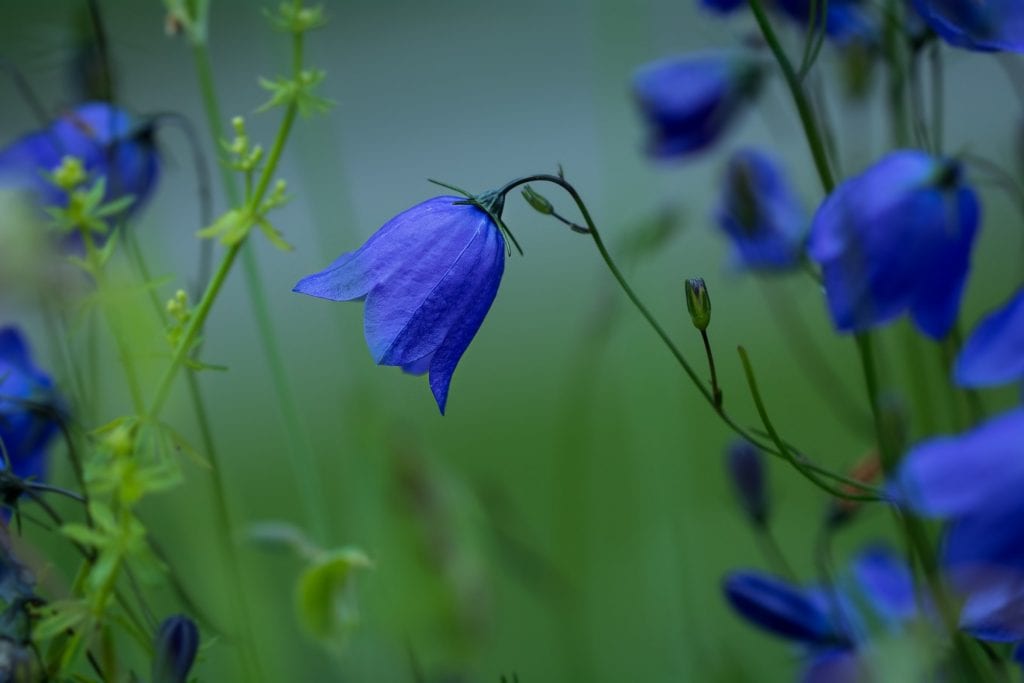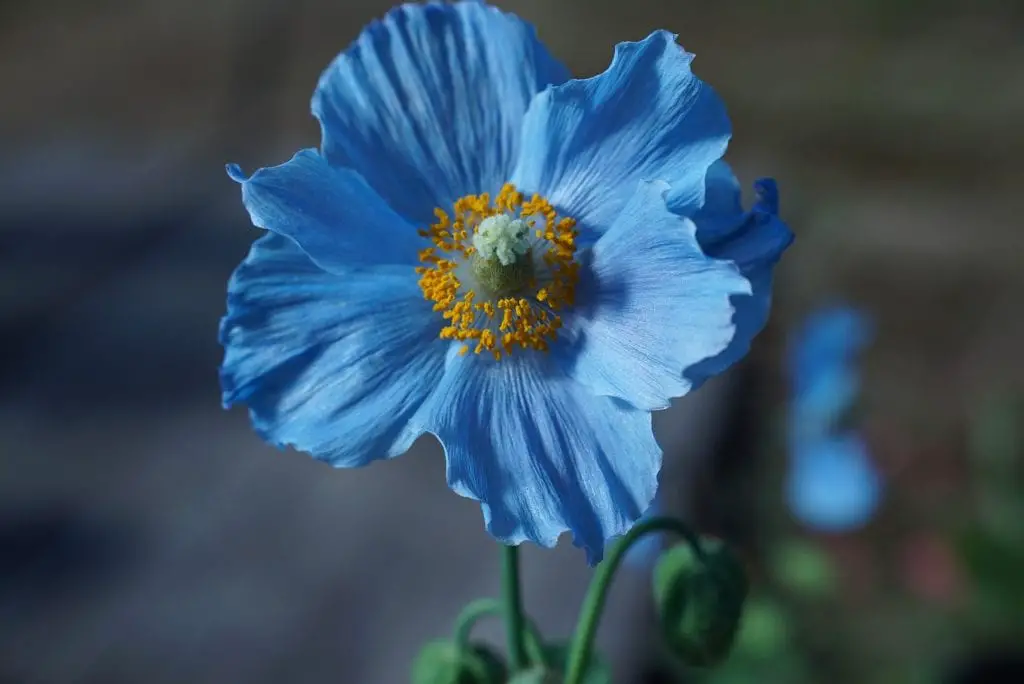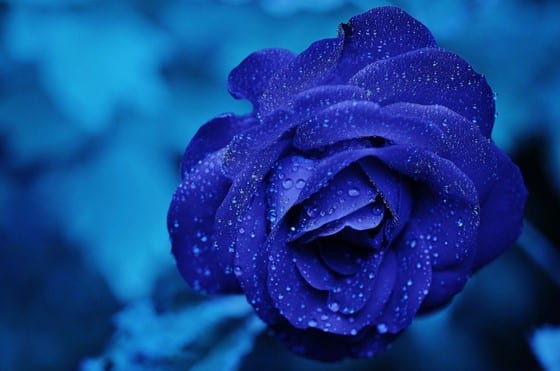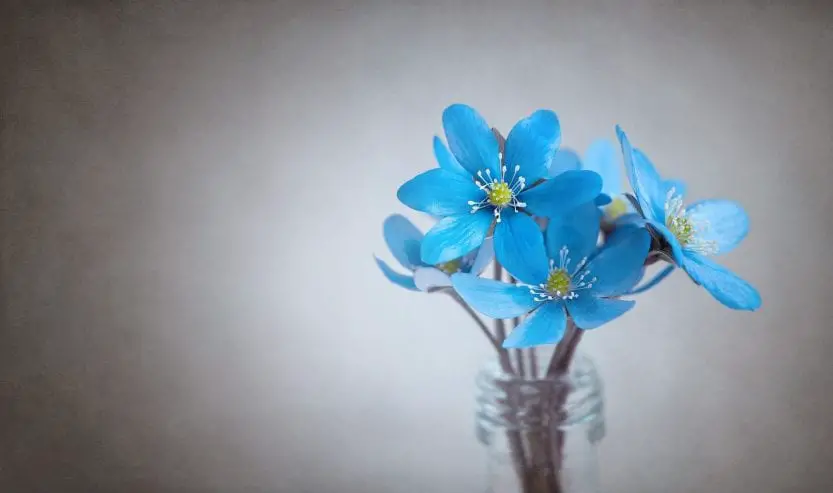Blue flowers inspired an entire generation of thinkers, artists and philosophers. The blue flower symbolism was central to the eighteenth-century Romanticism movement. Across time and space, blue flowers have been cherished for their ability to invoke emotions and reflect human aspirations. Blue flowers represent the infinite azure of the sky and the unreachable depths of the sea. They sometimes stand for hopeful longing and love, and sometimes for denial and loss. Blue flowers bring us closer to the gods, and they give us a glimpse into the world of the divine.
Blue flowers represent love, romance and desire
In the language of symbols, dreams and magic, many blue-colored flowers are associated with love — love longed for, unrequited love, or love fulfilled.
- Blue African Lily (Agapanthus), also known as Lily of the Nile, is believed to possess the power of love. Dried flower roots of the plant are made into necklaces and worn by the women of the Xhosa tribe as fertility talismans.
- The symbolic attributes of the Blue Bellflower (Phacelia campanularia) are constancy, lack of pretension and ‘Thinking of you’. This is a flower of never-ending love and devotion.
- In Ancient Greece, the Blue Cupidone flower (Catananche caerulea) was used as a key ingredient while casting love spells.
- The blue Bachelor’s Button flowers (Centaurea cyanus) symbolize hope and patience in love. Infatuated men used to wear it as a litmus test — is the flower faded too soon, it was a bad omen of unrequited love.
- Blue Gentian (Gentianopsis crinita) was also used in love spells, and it was believed to have the power to break a hex.
- Blue Indian Jasmine (Ipomoea) signified the two sides of the same coin — either attachment and love in vain, or love promises and affection.
- It is believed that the one who carries a Blue Balm flower (Melissa officinalis) eventually finds love. These love-bringing flowers also symbolize wish-fulfillment, sympathy and success.
- The Blue Vine Sage flower (Salvia cacaliifolia) can be gifted to a loved one, as it symbolically means ‘I think of you’.
- Blue Buttons (Vinca minor) is a flower of sweet memories and desires. It removes negative energy, retrieves lost memories, but also brings lust.
- Larkspur (Delphinium scaposum) is an old-fashioned flower which in the language of flowers (floriography) represents love and attachment.
- In the Victorian Era, women were discouraged from plucking blue Hortensia flowers (Hydrangea). It was believed that doing so would prevent them from finding a good husband.

Blue flowers represent luck and protection
Many blue flowers represent protection from negative energy and wicked spirits. Some blue flowers end periods of misfortune and bestow good luck.
- Blue primrose (Primula vulgaris) brings eternal love, pleasure and happiness. The one who carries it, can attract love. When grown in the garden, it believed to attract fairies who can bestow their protection upon the owner.
- Blue Violet (Viola odorata) protects against evil spirits and brings good luck. It is said that you must pick the first Violet flower you see in the spring, as it will fulfill whatever wish you make.
- Anemone (Anemone coronaria) has been traditionally used as a talisman against bad spells, misfortune and bad luck.
- A German story speaks of a legendary blue Luck-flower. Finding this blue flower is extremely difficult, but the one who possesses it can open the entry of caves full of riches. This legend sounds a lot like a version of the ‘Open Sesame’ story from the ‘Arabian Nights’.
Blue flowers as a symbol of the sky, divinity and spirituality
Since blue is the color of the sky, it often represents power, divinity, and spirituality. The color blue is often considered royal (‘blue blood’) and secures the grace of gods. Blue flowers represent man’s metaphysical pursuit of truth and meaning of life.
- The Picts (the people of northern Scotland) produced a blue dye from the Asp of Jerusalem flower (Isatis Tinctoria). The word ‘Pict’ means ‘painted’ in the Celtic language. Their warriors used it to paint their bodies in a particular shade of blue. This allowed them to gain the ‘cloak of invisibility’ against the sky azure, when standing on the top of a hill.
- The name of the Rosemary flower (Salvia rosmarinus) was coined of two Latin words —‘ros’ (dew) and ‘marinus’ (of the sea). It was later dedicated to Virgin Mary, and became known as the Rose of Mary. According to the tradition, the flower turned blue when Mary laid her cloak on a roadside bush. There is a popular folk belief which says that a rosemary bush lives for 33 years (the age of Jesus at the time of his crucifixion).
- Early Americans believed that the Blue Sailors flower (Cichorium intybus) could bring luck and help remove obstacles. A person blessed with the juice of the flower (a kind of anointment) secured respect and support from others.
- The Blue Passionflower (Passiflora caerulea) represents faith, piety and suffering (often referring to crucifixion).
- Leadwort (Plumbago), the poisonous lead-blue flower, is a symbol of spiritual desire.
- Blue Waterlily (Nymphaea nouchali) is known in India under the names Neel Kamal and Krishna Kamal. The flower is named after Lord Krishna. The story goes that Krishna, in an effort to gain the blessings of the goddess Durga, needed to make an offering of a hundred blue lotus flowers. Since he could only collect 99 of them, he plucked out one of his blue eyes and offer it as the hundredth flower. This, of course, pleased the goddess, and she granted him the blessings which he needed to defeat the demon Ravana and rescue his wife Sita.
- Another blue flower often related to Lord Krishna is the Flax flower (Linum usitatissimum), also known as Atasi in India. The flower is compared to Krishna’s blue complexion (the skin of many Indian gods and goddesses is often depicted as blue).
- The blue flowers of the Butterfly Pea plant (Clitoria Ternatea) are used in worshiping of the Indian goddess Durga.
- The Bourbon Kings of France used blue Iris (Iridaceae) as a symbol of their royalty and power.

Blue flowers sometimes represent loneliness, sadness and melancholy
Blue color can sometimes have less-favorable connotations. At least two phrases in the English language testify to this — ‘feeling blue’ (depression and sadness) and ‘baby blues’ (postpartum depression). The blues is a genre of music which embeds a great deal of melancholy. Many popular songs use the phrase ‘Blue Moon’ in reference to feelings of loneliness and sadness.
- There is a hauntingly beautiful tale told of the blue, Forget-Me-Not flower (Myosotis scorpioides). A couple in love noticed pretty blue flowers on a small island in the middle of the River Danube. Wishing to gift those flowers to his beloved, the man swam into the water, reached the islet, and plucked a few blue flowers. However, while swimming back towards the river shore, he drowned. Seconds before disappearing under the surface, he managed to trow the bunch of flowers towards his lady, and cried loud — ‘Forget Me Not!’. These flowers, named after his last words, were cherished by the girl for the rest of her life. She always wore them in her hair.
- According to a Greek legend, the blue Hyacinth flower (Hyaninthus orientalis) grew from the blood of Hyakinthos, a handsome Spartan prince and Apollo’s lover. The sudden accidental death of Hyakinthos put Apollo in a state of despair. Apollo promised never to forget Hyakinthos, and inscribed mourning words on the petals of the Hyacinth flower which grew from the blood of his lost lover.
Blue flower for peace, tranquility and serenity
Blue flowers can be gifted to a friend or a loved one who is experiencing a difficult phase in life, such as illness, failure or loss. In times of grief and mourning, the blue flowers offer consolation and represent hope.
- Salvia (Salvia divinorum) or Sage is a ‘Get Well Soon’ flower, and it signifies the process of healing. Etymologically, the word Salvia comes from the Latin ‘salvere’ (health, wellness).
- The blue Lupine (Lupinus) represents resilience and recovery from a traumatic experience. It is a flower of regeneration.
- In Ancient Greece, women were buried with blue Iris flowers (Iridaceae) to secure a smooth journey in the afterlife.
- The pretty Globe Thistle (Echinops bannaticus) is a symbol of fortitude and endurance.
- In spite of its fragile appearance, the blue Glory of the Snow flower (Scilla forbesii) blooms at the end of the winter. It has therefore earned the epitome of strength and ability to withstand a difficult time.

Blue rose represents the unattainable
While roses come in different colors and shades, creating a real blue rose has remained an unfulfilled dreams till date. Through genetic engineering, scientists claim to have finally produced a blue rose. However, the actual color of this GM rose is rather lavender or pale mauve. In the market today, artificially tainted blue roses are available.
This feverish pursuit of a blue rose has its origin in an old Chinese folktale. An Emperor’s daughter, refusing to get married, thought of an impossible condition for its suitors — she demanded a blue rose. As destiny would have it, one day she fell in love with a traveling singer who was passing through the city. Although he did everything to find a blue rose, he failed. However, by offering a white rose, he asked the Emperor for a permission to marry his daughter. The Emperor objected, saying that the rose was white. However, the princess denied it and claimed that the true color of the rose was blue. The Emperor, wanting to see his daughter happy, finally blessed their marriage.
The blue rose has thus become a symbol of an impossible, unattainable pursuit or love.
A blue flower is generally considered a gender-neutral gift. However, some people prefer to choose darker shades of blue (close to indigo) when gifted to men, and pale shades when gifted to women. There is no need to overthink it. Blue flowers are unique, and their message is rarely misunderstood.



